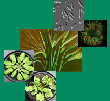| Schmidt, H; Günther, C; Weber, M; Spörlein, C; Loscher, S; Böttcher, C; Schobert, R; Clemens, S: Metabolome analysis of Arabidopsis thaliana roots identifies a key metabolic pathway for iron acquisition., PLoS ONE (2014), doi:10.1371/journal.pone.0102444 | |
| Abstract: Fe deficiency compromises both human health and plant productivity. Thus, it is important to understand plant Fe acquisition strategies for the development of crop plants which are more Fe-efficient under Fe-limited conditions, such as alkaline soils, and have higher Fe density in their edible tissues. Root secretion of phenolic compounds has long been hypothesized to be a component of the reduction strategy of Fe acquisition in non-graminaceous plants. We therefore subjected roots of Arabidopsis thaliana plants grown under Fe-replete and Fe-deplete conditions to comprehensive metabolome analysis by gas chromatography-mass spectrometry and ultra-pressure liquid chromatography electrospray ionization quadrupole time-of-flight mass spectrometry. Scopoletin and other coumarins were found among the metabolites showing the strongest response to two different Fe-limited conditions, the cultivation in Fe-free medium and in medium with an alkaline pH. A coumarin biosynthesis mutant defective in ortho-hydroxylation of cinnamic acids was unable to grow on alkaline soil in the absence of Fe fertilization. Co-cultivation with wild-type plants partially rescued the Fe deficiency phenotype indicating a contribution of extracellular coumarins to Fe solubilization. Indeed, coumarins were detected in root exudates of wild-type plants. Direct infusion mass spectrometry as well as UV/vis spectroscopy indicated that coumarins are acting both as reductants of Fe(III) and as ligands of Fe(II). |

last modified 2021-05-27

